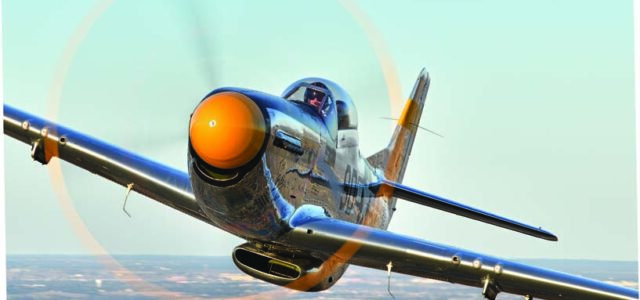Science-fiction writer and aeronautical engineer Robert Heinlein famously said, “A generation which ignores history has no past—and no future.”
Warbird aircraft have been a part of American life since airplanes were adapted for warfare during World War I. Almost immediately afterward, the newly-surplus “war birds” that a few years before had served as fighters, bombers and trainers were turned to other uses, from aerobatic barnstorming and air racing to crop-dusting.
Following World War II, they also featured in airshows as animate reminders of American history and sacrifice. Over the course of almost eight decades since the war’s end, roughly three generations of warbird pilots, maintainers, restoration specialists and collectors have preserved the ex-military aircraft so often featured at airshows and in the pages of Flight Journal.
Many of us take them for granted, assuming there will always be warbirds flying that we can see, hear, smell, and sometimes touch or even buy a ride in. One look at a beautifully restored or maintained P-51 Mustang or B-17 Flying Fortress thundering past a crowd at an airshow is reassuring.
People, not airplanes, are the literal lifeblood of warbirds, but the warbird operators many of us have come to know are aging. For this passion-driven reminder of American history to fly into the future, a new, younger generation of warbird people must emerge.
The good news is there’s a crop of men and women in their 20s and 30s who are already beginning to displace more “experienced” warbird fliers and fixers. We thought it was about time to introduce them to you in this and a series of coming articles that profile members of the warbird world’s new generation.
Parker Rathbun 〉〉 High Sky Wing Pilot, Commemorative Air Force (Nakajima BN5 Replica, T-6, PT-19)
“Flying Tora is so fun!”
At just 22 years old, Parker Rathbun is one of the newest in a long line of warbird pilots who have been a part of the Commemorative Air Force’s (CAF) iconic “Tora, Tora, Tora” flight demonstration, a living history lesson that brings to life the events of December 7, 1941 and the Japanese attack on Pearl Harbor.
Last April’s Great Texas Airshow at Joint Base San Antonio-Randolph marked Parker’s debut with Tora, flying one of the CAF’s three replica Nakajima BN5 “Kate” torpedo bombers. The CAF’s BN5s are part of the group of Kate replicas originally built for the famed 1970 movie, “Tora, Tora, Tora!”
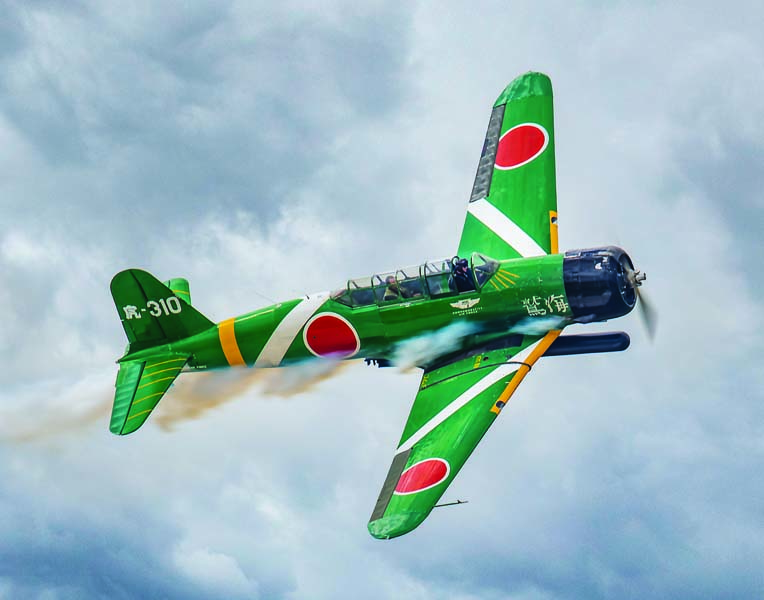
The “Kate” replica Rathbun is banking in front of a crowd here is one of three that belong to the CAF, part of the group of nine T-6-based replicas originally built for the 1970 hit movie “Tora, Tora, Tora!” (Photo by David T. Gillen)
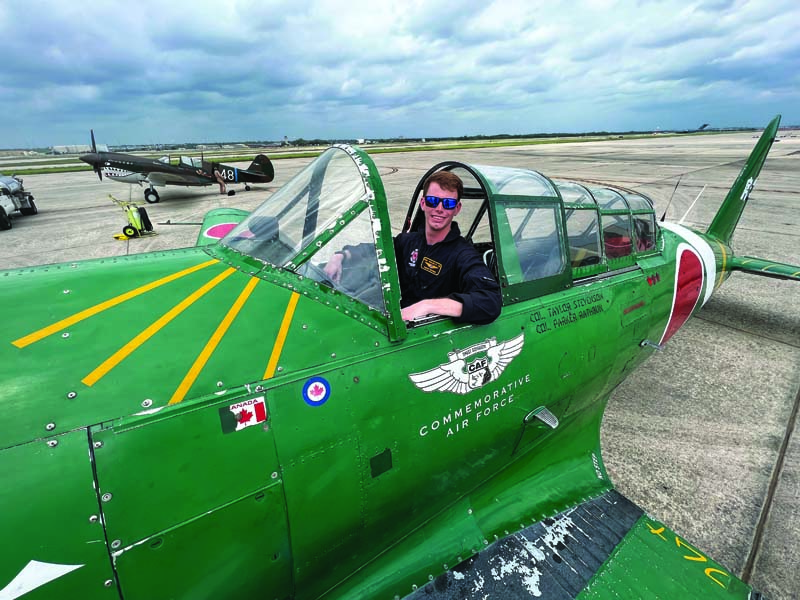
Twenty-two year old Parker Rathbun is one of the newest “Tora, Tora, Tora” display pilots for the Commemorative Air Force. He flies a replica Nakajima BN5 “Kate” torpedo bomber in the famed display. (Photo by Miles Turner )
Fifty-two years later, seven of the nine T-6 Texan-based replicas created for the film remain, having created a lot of airshow history in their own right. Rathbun’s participation in Tora is a rite of passage into the warbird world many before him have made.
“You start thinking about how many guys have flown them and the people that have taken care of them,” Rathbun marvels. “I really wanted to fly a full season of Tora with the current guys, the old guard like Mike Burke [lead pilot], because it will be really cool looking back that I got to fly with that generation of pilots!”
Burke has been flying with Tora for five decades, more than twice as long as Rathbun has been alive. But Parker has packed a lot of experience into his 22 years. His aviation passion was inspired by his father, Daniel Rathbun, a longtime corporate pilot, Tora pilot and newly minted pilot of the CAF’s “Tex Hill” P-40N Warhawk.
From childhood, Rathbun flew radio-control model aircraft, a hobby he continues today. By the age of 12, he’d already had the opportunity to ride along in the Dassault Falcon 2000 bizjets his dad flew and started flying his family’s Beech Musketeer with his flight instructor father.
Volunteering with the CAF started in 2014 for Rathbun, cleaning, polishing, and doing light work on warbirds while getting to fly in the local wing’s T-6 when his dad checked out in it that year. By 2016, Daniel Rathbun had a T-6 of his own, having purchased an AT-6F best known for its air racing exploits as Pat Palmer’s #99 “Gotcha!”
“You have no time or energy to be nervous,” he says. …“You focus on your tarps [flying over pyrotechnics], your pattern, and who you’re following. You’re just flying your part of the show and it’s really a blast!”
Soon thereafter, Rathbun qualified for his private license and, with tailwheel time already accumulated in a Super Decathlon, started flying his family’s T-6.
“I really got used to how it handled from the back seat for a year and a half, then hopped in the front seat when I was 17,” Rathbun says, adding that he and his father practiced crosswind landings over and over until one day when his dad said, “Taxi over here real quick.”
“We had just done some landings and he hopped out of the back seat. I flew it around the pattern by myself. It was cool.”
Racking up many more hours in the T-6 with and without his father was followed by T-6 formation clinics and gaining enough time and experience that he was invited to qualify as one of the Tora pilots.
“I had gotten to see Tora ever since I was a little kid and meet some of the guys doing that when I was 14 or 15. When I was 17, I went to the yearly Tora practice for the first time with my dad. It was something I definitely wanted to do and I really started learning the pattern of what they do then, watching and standing in the back of debriefs or discussions.”
In 2021, Rathbun acted as a ferry pilot flying the Kate to airshows in Topeka, Kansas and EAA’s massive Air Venture in Oshkosh, Wisconsin.
For the last two years, he’s also been a corporate pilot, flying charters in a Pilatus PC-12. This year he has dialed back his corporate work to allow himself to fly with Tora.
“You have no time or energy to be nervous,” he says. “You focus on your tarps [flying over pyrotechnics], your pattern, and who you’re following. You’re just flying your part of the show and it’s really a blast!”
Casey Wright 〉〉 Flight Operations Mechanic, Yanks Air Museum
Yanks Air Museum in Chino, California is home to one of America’s premier warbird collections, with more than 200 historic aircraft spanning early aviation to modern jet fighters.
Thirty-four year old Casey Wright is one of the museum’s top mechanics and restorers. He’s also part of an oft-overlooked segment of the warbird world—the extremely talented guys and gals who keep ’em flying. The specialist knowledge of the relatively tiny cadre of folks who work on warbird engines, airframes, and systems is a precious commodity. Bringing a new generation to this sometimes arcane business is essential for the warbird community’s survival.
Like Rathbun, Wright has aviation in his blood. His grandfather, Charles Nichols, began the Yanks collection in 1973 and still guides the museum today. Nichols, Wright’s father, and his sister are all pilots, but “I never went down that road,” he says.
Instead, he tapped into the family’s heritage in mechanics. His paternal grandfather was a mechanic with the 501st Bombardment Group in WW II, and his father was a talented diesel engine and aviation mechanic as well. As a child, Wright spent days with his dad learning to fix two-stroke diesel engines and worked on some of the aircraft in his grandfather’s collection.
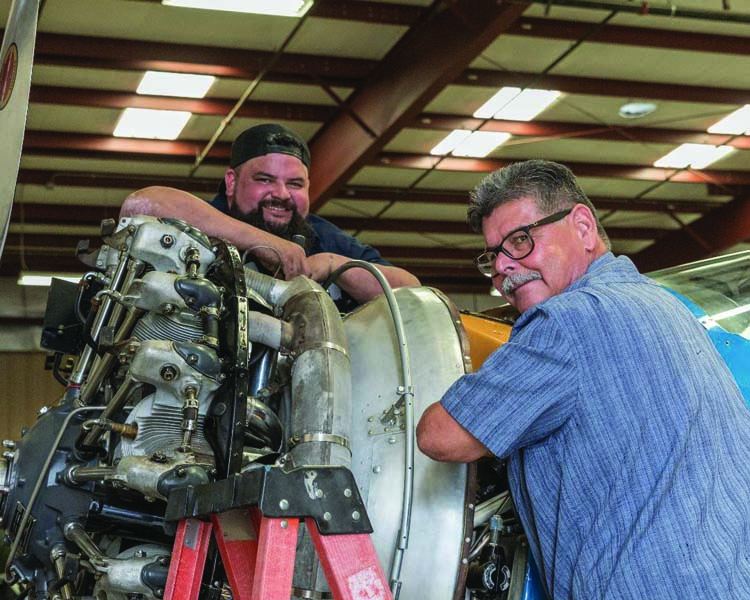
Casey and his father Frank Wright, the man who inspired his love for mechanics and warbirds, wrench on the Pratt & Whitney R-985 nine cylinder radial that powers the airplane that began the Yanks collection in 1973—a Beech UC-43 Staggerwing. (Photo by Richard Takenaga)
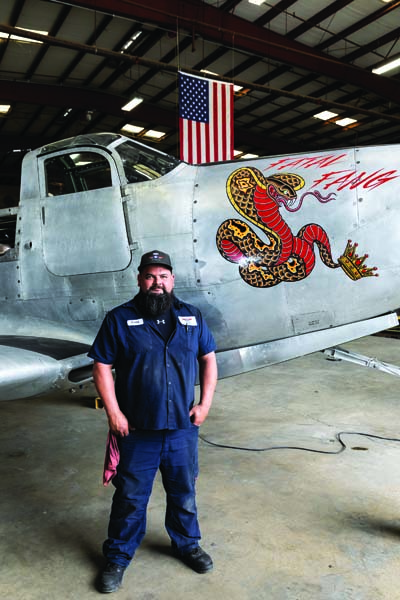
Casey Wright, a 34-year-old Flight Operations Mechanic with Yanks Air Museum in Chino, California, stands in front of Yanks’ terrific P-63A. Wright has had a major role in restoring and bringing the King Cobra back to airworthy condition. (Photo by Gerald Willig)
He’s proudest of the blood, sweat, and tears he’s put into Yanks’ P-63A King Cobra … “Once it started and there was oil pressure and case pressure in the nose … I can describe it with only two words: pure happiness. That’s second best only to seeing it fly.”
His father encouraged him to go to college and pursue a different career. Casey graduated and went to work for ammunition manufacturer Berger Bullets. A firearms enthusiast, he thought he’d be working on guns but spent most of two years “looking at Excel spreadsheets.” When the company announced it was moving from California to Arizona, Casey decided the business wasn’t for him.
“I told my Dad, ‘I want to come back and work on airplanes.’”
“He said, ‘No you don’t. You’ve got a college degree and you want to do more with your life. You don’t want to be a mechanic like me.’”
“I said, ‘I love it too much, Dad. It’s always going to be in my blood, whether I’m working on a motorcycle, a car or an airplane.’”
And with that he joined the family business that is his real passion. He also began absorbing all of the knowledge he could about working on warbirds, learning from Yanks’ mechanics including Bobby Carter and Randy Purdey, museum pilots, and the community of restorers and maintainers that exists at Chino Airport.
Wright’s first project was installing a full feathering prop kit on Yanks’ Lockheed C-40, tricky work given the complexity of the Pratt & Whitney R-985 nine cylinder radials that power the twin-engine transport.
“Breaking into an engine with that many moving pieces was really fun for me,” he says, adding that the airplane is “really finicky” and that he’s constantly fixing things to make it “perfect.”
Next, he participated in the restoration of the museum’s P-40E, helping to bring the Warhawk back to flyable condition while learning as much as he could along the way. Wright says his work on the P-40 is his biggest achievement. But he’s proudest of the blood, sweat, and tears he’s put into Yanks’ P-63A King Cobra, spearheading a project that has taken four years.
“During the pandemic. I spent the year and eight months that we were locked down at the museum with Joe Yancey, in his hangar building the Allison for the P-63,” Casey notes.
The knowledge he gained from working with Allison V12 expert Yancey—who runs Yancey Allison Engines at Chino—was invaluable, culminating last August with an engine run that marked first time the King Cobra had come alive since 1979.
“Once it started and there was oil pressure and case pressure in the nose … I can describe it with only two words: pure happiness. That’s second best only to seeing it fly.”
The P-63A was scheduled for its maiden test flight in mid-June, an event sure to have put a big smile on Wright’s face.
Ben Wilson 〉〉 Pilot, Cavanaugh Flight Museum (P-51, B-25, C-47, T-28, Caribou, Stearman)
“I would not have gotten through any of these steps along the way if there wasn’t somebody who was willing to help me,” Ben Wilson says modestly.
Modestly because 31-year old Wilson carved his own path to becoming a warbird pilot by combining desire and enthusiasm with a willingness to work hard and form relationships that could help him achieve his goal.
Unlike Rathbun, Wright, and many others who are part of the warbird world, Wilson had no aviation background and didn’t start flying and pursuing an aviation career until he enrolled at Oklahoma State University.
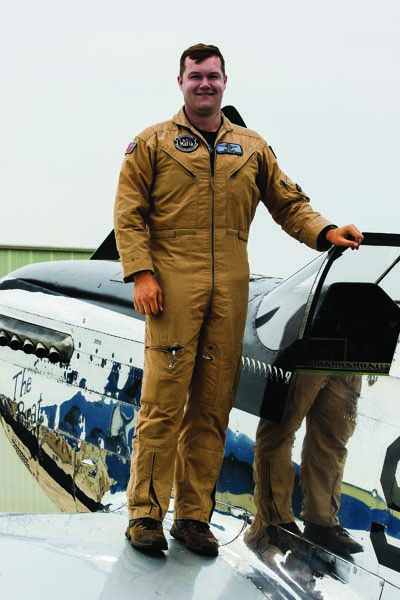
Ben Wilson stands on the wing of the Cavanaugh Flight Museum’s P-51D, “The Brat III.” (Photo by Greg Morehead)
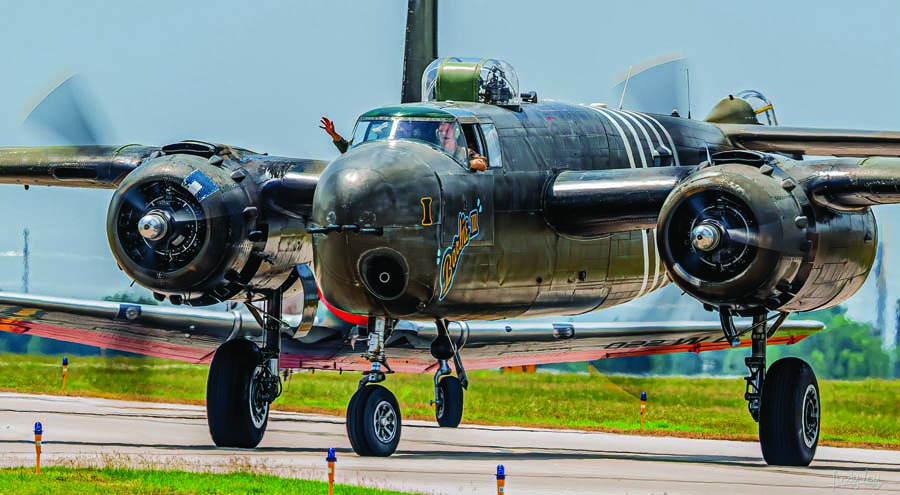
Wilson taxis Cavanaugh’s B-25H “Barbie III.” Flying the museum’s CV-2B Caribou helped Ben build multi-engine experience toward flying “Barbie III” and the C-47. (Photo by Andy Lay)
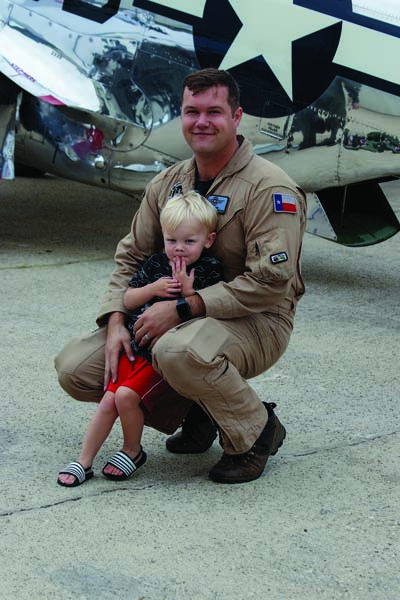
Wilson poses in front of “The Brat III” with another of his proudest achievements, his son Hayden. When not flying warbirds, Ben flies MD-11s as a first officer with FedEx. (Photo by Joe Cieliesz)
It was a ride in the CAF Gulf Coast Wing’s B-17 “Texas Raiders” during an airshow that lit a fire within him to get close to and ultimately fly warbirds himself. Wilson then did everything he could to make his dream a reality even though, initially, he had no idea how to make it happen.
“The Mustang is pretty hard to beat. It’s not only the prestige of knowing what this airplane represents and what it did. It’s a genuine, honest-flying airplane, a joy to fly.”
By chance, a church friend introduced him to some of the staff/volunteers with Cavanaugh Flight Museum in Addison, Texas. Following Wilson’s first year at college, he started volunteering at Cavanaugh during the summer.
“I showed up, wanted to be there and explained that to them,” Wilson says. “That’s how I got behind the ropes. I started meeting people and mostly cleaning airplanes and hangar floors. That was quite a shock, walking into the hangar being a volunteer and standing in front of a Mustang thinking, ‘I’m supposed to wipe this thing down!’”
Thereafter, Wilson would show up “every day during the summers” getting to know everybody involved with the museum, from its director on down, while simultaneously building skills at OSU for an aviation career.
“I’d take that experience and grow my enthusiasm throughout the semester, work on flying progression, getting other ratings, building time and go back to Cavanaugh for Christmas break or semester break. I’d run back to the museum every chance I could.”
Gradually the staff at Cavanaugh became aware of Wilson’s enthusiasm and aviation skills. As college progressed he earned multiple ratings and began working as a flight instructor. He wondered how he might get involved in the flying part of the museum and asked. The museum staff told him the easiest way to build the necessary 200 hours of tailwheel aircraft experience would be to buy a taildragger.
That somewhat daunting prospect didn’t deter Wilson. He found a bank that would give him a loan and, with help from the aviators at Cavanaugh, found a “janky 1949 Cessna 170 that was three shades of lime green but perfect!”
The $19,000 Cessna was now his, but he didn’t have enough money for fuel.
“So through people I’d made connections with, I started interning with a small flight department that operated Cessna Citations in Oklahoma. I instructed the airport manager there, trading flight instruction for a fuel credit. I mowed the lawn, helped the flight department any way I could, and they let me keep my 170 in their hangar.”
Flying the 170 to the museum as often as he could, Wilson made sure he was available when any opportunity arose. When it appeared the museum might need a pilot to volunteer to give rides in its Stearman, Wilson asked if there was a chance he could be trained for the task. Cavanaugh pilot Chuck Gardner checked him out and by 2014, he was flying the museum’s PT-13.
By 2016, Wilson had graduated from college and was flying Beech 99s and 1900s for Ameriflight from Dallas while getting checked out in Cavanaugh’s T-6 and its DeHavilland CV-2B Caribou.
“That helped me get experience to get into some of the crewed warbirds. I was able to build higher horsepower multi-engine time and that made me a realistic option for flying the C-47 and B-25.”
The time Wilson had spent around the museum led to another opportunity, flying Dassault Falcons for Jani-King founder Jim Cavanaugh’s flight department.
“It came full circle,” Wilson says. “It started with knowing the chief pilot as my ‘in’ to the museum. Then five or six years later, he ended up hiring me to be one of the corporate pilots. I ended up flying their Falcons, got to know Mr. Cavanaugh better and started flying the T-28s he had in Florida.”
In 2020, Ben checked out in Cavanaugh’s P-51D “Brat III,” one of the only surviving Mustangs with a combat history as a part of the 370th Fighter Group in England.
“The Mustang is pretty hard to beat. It’s not only the prestige of knowing what this airplane represents and what it did. It’s a genuine, honest-flying airplane, a joy to fly.”
This year, Wilson is hoping to complete a check out in one of Cavanaugh’s two Skyraiders. None of the opportunities he has pursued would be possible without a positive outlook.
“Be humble about your expectations,” he advises. “Be realistic and be happy to be behind the ropes!” ✈
By Jan Tegler



